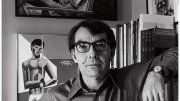“Unless the work of art has wholly exhausted its maker’s attention, it fails,” Guy Mattison Davenport Jr., Ph.D. ’61, once advised. “This is why works of great significance are demanding and why they are infinitely rewarding.” The author, artist, and professor lived up to his own advice, producing works both deeply edifying and unclassifiable: nearly 50 books of fiction, essays, commentary, poetry, and translations. The arts, for him, were an attempt to explain the nature of things rather than, as science does, the “mechanics of everything.” In this sense, he considered himself a teacher foremost, and his writings “an extension of the classroom.”
He often joked that he had only 13 to 18 readers, but he also asserted he didn’t write “for scholars or fellow critics, but for people who like to read, to look at pictures, and to know things.” By one account, he traded mail—often including drawings and paintings—with more than 2,300 people, including John Updike, Cormac McCarthy, Joyce Carol Oates, and Dorothy Parker. Many who sought out his work considered him one of the greatest prose stylists of his generation. Erik Reece, a former student and friend, recalled experimental writer Donald Barthelme once greeting Davenport at an award ceremony with “I read you in hardback.”
The South Carolina-born Davenport, the son of a Railway Express shipping agent and a Baptist housewife, wrote that ambition was “unknown” to his family and his “childhood was far from bookish,” but his restless, singular mind emerged early. He left high school in tenth grade, heading north to attend Duke as a “desperately poor” undergraduate, “romantically and self-indulgently lonely,” focused on English and classics. Nevertheless, he landed a Rhodes scholarship—and would publish the first Oxford thesis on James Joyce.
Two years of military service and a teaching stint at Washington University intervened before he began a doctorate at Harvard, studying under literary critic Harry Levin and serving as a teaching assistant for poet Archibald MacLeish. In a 2002 Paris Review interview, Davenport recalled how Levin’s seminar on Melville greatly influenced his own thoughts on “iconography”—“how to read images in a text—that literature is as pictorial as painting or sculpture.” Otherwise, he said, he “learned early on that what I wanted to know wasn’t what I was being taught.”
Ezra Pound perhaps inspired him most. They met in the 1950s, while the poet was incarcerated for treason and Davenport, working on an article about Pound, wrote to him. Pound invited Davenport to visit, and they corresponded until Pound’s death. They didn’t share political beliefs, but Davenport wrote his dissertation on the poet’s Cantos and once said the best interpretation of his own work was that he was trying to do in prose what Pound did in poetry: make “ideographs.” He was enchanted by the idea that Pound and his contemporaries modernized the arts not by creating something new from scratch, but by bringing something ancient up to date: James Joyce reworking the Odyssey, for instance, or Picasso recasting African masks. Davenport’s aesthetics were akin. He called his writing style primitive and routinely referred to his stories as “assemblages”: collage-like vignettes where a page was “a texture of images” that he used to construct prose from his knowledge of philosophy, natural history, archaeology, and other subjects. “Art,” he once wrote, “is the attention we pay to the wholeness of the world.”
In 1963, Davenport settled in at the University of Kentucky and taught English until winning a MacArthur fellowship in 1990. In class, his student Paul Prather recalled, if an essay they were reading mentioned a bar of soap, “Davenport would stop in mid-sentence and launch into a 10-minute soliloquy on the significance of soap: its origins in the ancient world, how rarely various kings and queens of English history bathed, when the habit of daily baths caught on, the changes in soap’s ingredients over the centuries. Then, seamlessly, he’d resume reading.” On a broader level, Davenport often declared that the purpose of imaginative reading was “precisely to suspend one’s mind in the workings of another sensibility.”
When it came to fiction, the usually precocious writer bloomed late. Tatlin!, his first collection, appeared in his forties. Some of the stories blurred the line between fact and fiction: “The Richard Nixon Freischütz Rag,” for instance, has Nixon chatting with Mao Tse-tung; Leonardo da Vinci tinkering with a bicycle; and Gertrude Stein and Alice B. Toklas visiting Assisi. His nonfiction roamed as freely: one celebrated essay, “The Geography of the Imagination,” connects, among other things, Helen of Troy to Edgar Allan Poe, Gnosticism to Pinocchio, and an Athenian mime to Mark Twain.
Davenport wasn’t a political writer but had a radical idealistic streak: he was a devotee of the French utopian philosopher Charles Fourier, who believed the suppression of desire ruined civilization. In compiling his final book, The Death of Picasso, Davenport drew largely from his stories reflecting Fourier’s ideas. Characters in several of them seek ways to invent their lives as they see fit, just as he sought to do with his imagination. Indeed, for Davenport, the imagination was that vital key for unlocking the best bits of humanity. “For without desire, the imagination would atrophy,” he wrote in the essay “Eros, His Intelligence.” “And without imagination, the mind itself would atrophy, preferring regularity to turbulence, habit to risk, prejudice to reason, sameness to variety.”








